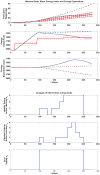Hybrid Model Predictive Control for Sequential Decision Policies in Adaptive Behavioral Interventions
- PMID: 25635157
- PMCID: PMC4307847
- DOI: 10.1109/ACC.2014.6859462
Hybrid Model Predictive Control for Sequential Decision Policies in Adaptive Behavioral Interventions
Abstract
Control engineering offers a systematic and efficient method to optimize the effectiveness of individually tailored treatment and prevention policies known as adaptive or "just-in-time" behavioral interventions. The nature of these interventions requires assigning dosages at categorical levels, which has been addressed in prior work using Mixed Logical Dynamical (MLD)-based hybrid model predictive control (HMPC) schemes. However, certain requirements of adaptive behavioral interventions that involve sequential decision making have not been comprehensively explored in the literature. This paper presents an extension of the traditional MLD framework for HMPC by representing the requirements of sequential decision policies as mixed-integer linear constraints. This is accomplished with user-specified dosage sequence tables, manipulation of one input at a time, and a switching time strategy for assigning dosages at time intervals less frequent than the measurement sampling interval. A model developed for a gestational weight gain (GWG) intervention is used to illustrate the generation of these sequential decision policies and their effectiveness for implementing adaptive behavioral interventions involving multiple components.
Figures


References
-
- Kumar S, Nilsen W, Pavel M, Srivastava M. Mobile health: Revolutionizing healthcare through transdisciplinary research. Computer. 2013;46(1):28–35.
Grants and funding
LinkOut - more resources
Full Text Sources
Other Literature Sources
Medical
